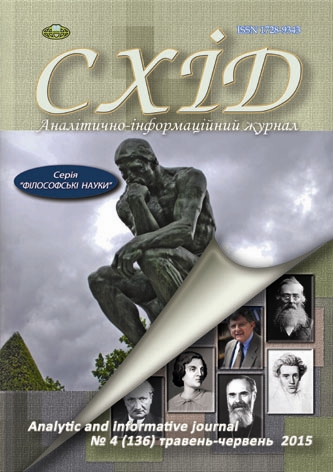Understanding of the religion's essence, classification and origin in Kostomarov's works
DOI:
https://doi.org/10.21847/1728-9343.2015.4(136).48347Keywords:
religious experience, faith, religious studies thought, mana, animism, magic, evolution of religion, symbolism, natural religion, positive religionAbstract
In the late 19th century, religion became an object of scholar enquiry. But the interest in religion as an important sphere of human life has existed previously.Today, we have a lot of information about the problems of religion. This paper examines the view on religion by Mykola Kostomarov, who was a representative of scientific thought of the 19th century.
M. Kostomarov is often seen as a historian, and therefore other aspects of his scholar activity are not examined well. For example, his thoughts about religion have not been studied at all. We will look at some aspects of his religious thought in the context of classical religious studies.
By studying the problem of the essence of religion, its classification and origins in Kostomarov's work, we have identified the basic idea: religion is a relation to the sacred; and religiosity is an innate human quality. The idea of innate religiosity was thoroughly examined by religious studies cholars from the early 20th century. The evolution of religious feeling in Kostomarov's works, expresses itself in two phases: natural religions and supernatural religions or revelation religions. Therefore we can talk about the possibility of classifying religion. The classification relates to Kostomarov's evolutionism and does not constitute scientific value today. Studying the works of this scholar we have determined that some of the ideas presented in the 1770's were actively developed by religious studies scholars in the early 20th century. The Kostomarov's idea of three sources of religion seems to be very interesting. The idea of a primary form of religion from which all others developed was criticized by N. Sederblom in 1915. He proposed to recognize that there are three of such forms and they exist and develop in parallel.
We studied the works of Mykola Kostomarov and identified the presence of theological thought. The theoretical problems present in his works are not enough developed. At the same time, some of the author's thoughts are far ahead interest in classical religious studies. Therefore, the study of M. Kostomarov's thought as a representative of religious studies provides an opportunity to consider the potential of Ukrainian scholars.References
Soderblom N. (1998), The Living God, in Religiya. Nauka. Klassiki mirovogo religiovedeniya. Antologiya, Kanon+, Moscow, book 1, pp. 262-314 (rus).
Kostomarov N. (1994), Autobiography, in Slovianska mifolohiia. Vybrani tvory z folklorystyky y literaturoznavstva, Lybid, Kyiv, pp. 428-651 (ukr).
Kostomarov N., Two Russian nationalities, available at: http://litopys.org.ua/kostomar/kos19.htm (rus).
Kostomarov N. (1994), A few words about the Russian Slavs mythology in the pagan period, in Slovianska mifolohiia. Vybrani tvory z folklorystyky y literaturoznavstva, Lybid, Kyiv, pp. 257-297 (rus).
Kostomarov N. (1994), On the historical significance of the Russian folk poetry, in Slovianska mifolohiia. Vybrani tvory z folklorystyky y literaturoznavstva, Lybid, Kyiv, pp. 45-61 (rus).
Kostomarov N. (1996), Slovianska mifolohiia, Vybrani tvory z folklorystyky i literaturoznavstva, Lybid, Kyiv, pp. 201-256 (ukr).
Kostomarov N. (1905), The historical significance of the South Russian folk song creation, in Sobraniye sochineniy. Istoricheskiye monografii i issledovaniya, Society for the needy writers, Saint-Petersburg, book 9, pp. 439-459 (rus).
Krasnikov A. N. (2004), Мethodology of classical religious, Biblioteka zhurnala «Relyhyovedenye», Blagoveshchensk, 148 p. (rus).
Krasnikov A. N. (1996), At sources of modern religion, in Klasiki mirovogo religiovedeniya. Antologiya, Kanon+, Moscow, book 1, 17 p. (rus).
Lang A. (1998), “The Making of Religion”, in Religiya. Nauka. Klassiki mirovogo religiovedeniya. Antologiya, Kanon+, Moscow, pp.46-82 (rus).
Maret R. R. (1998), Mana and Tapu minimum definition of religion of the Threshold of Religion, in Religiya. Nauka. Klassiki mirovogo religiovedeniya. Antologiya, Kanon+, Moscow, pp. 99-109 (rus).
Muller F. M. (1996), Introduction to the Science of Religion, in Religiya. Nauka. Klassiki mirovogo religiovedeniya. Antologiya, Kanon+, Moscow, pp. 31-144 (rus).
Tylor Edward Burnett (1996), Primitive Culture, in Religiya. Nauka. Klassiki mirovogo religiovedeniya. Antologiya, Kanon+, Moscow, pp. 27-46 (rus).
Frazer James George (1996), Preface to“The Golden Bough”, in Religiya. Nauka. Klassiki mirovogo religiovedeniya. Antologiya, Kanon+, Moscow, pp. 82-99 (rus).
Henryk H. (2006), Religion and Religious Studies, Sevastopol, 124 p. (rus).
Downloads
Published
How to Cite
Issue
Section
License
Copyright (c) 2015 Oksana Levytska

This work is licensed under a Creative Commons Attribution-NonCommercial-NoDerivatives 4.0 International License.
1. Authors bear responsibility for the accuracy of facts, quotations, numbers and names used.
2. Manuscripts are not sent back.
3. The publisher does not always agree with the authors' opinion.
4. The authors reserve the right to authorship of the work and pass the first publication right of this work to the journal under the terms of a Creative Commons Attribution Non-Commercial License, which allows others to freely distribute the published research with the obligatory reference to the authors of the original work and the first publication of the work in this journal.
5. The authors have the right to conclude separate supplement agreements that relate to non-exclusive work distribution in the form in which it has been published by the journal (for example, to upload the work to the online storage of the journal or publish it as part of a monograph), provided that the reference to the first publication of the work in this journal is included.

